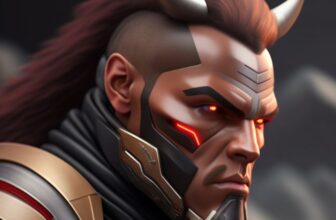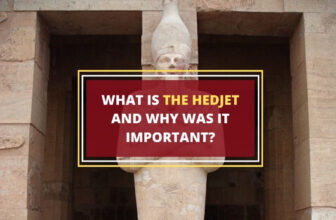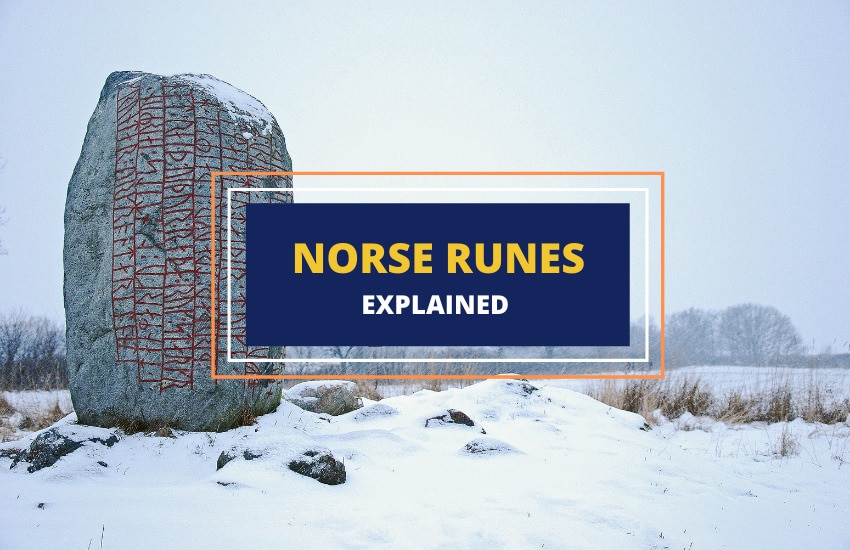
Table of Contents
Odin, the Allfather of Norse mythology, once impaled his own heart with the mighty Gungnir spear and hung from the World Tree Yggdrasil for nine days and nights. He did all this to gain knowledge of the ancient Norse runic letters and the magic and wisdom held within them. Luckily, we don’t need to go through such extremes today to learn about the Nordic runes. While there’s a lot about the old runes that have been lost to history, here’s what we do know.
Were the Runes Regular Letters?
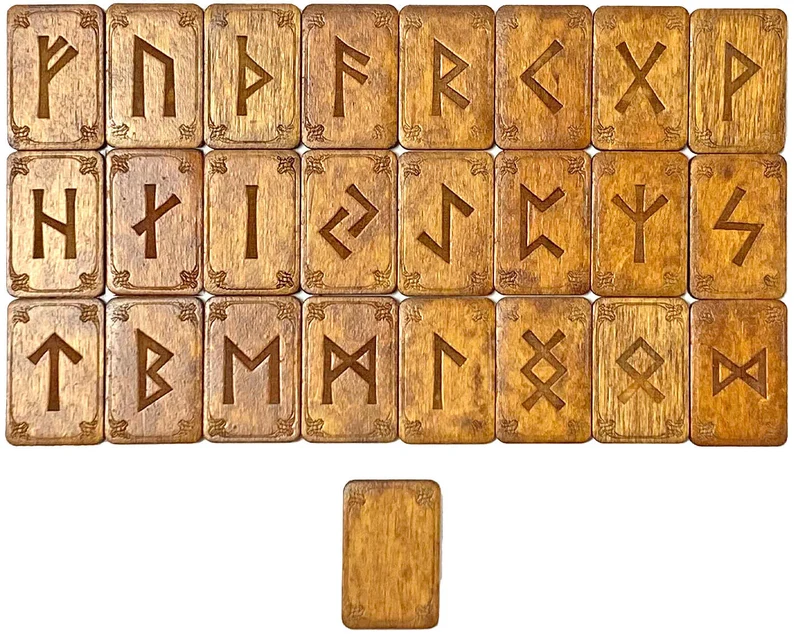
The Norse and Germanic people didn’t use the runes quite like other cultures used their letters. Instead, they believed that their runic symbols had a metaphysical nature and contained within them magical wisdom. They represented not just sounds and words but virtues, cosmic constants, and deep mysteries.
So, instead of writing their runes on parchment or animal leather, the Norse people carved them on stone, wood, and bone – hence the crude and sharp shapes of most Nordic runes. And, instead of using the letters for trade and communication, they used them to mark the graves of heroes, to honor their ancestors, or to predict the future. However, as time passed, they began to use their runes for more practical purposes just like the other cultures around them did.
The rapid rise of trade during the Viking Age between the 8th and 11th centuries saw the Nordic people spread and use their runes all across the continent and beyond.
With that evolution of Nordic culture, the runic alphabet evolved as well. That’s why most historians today recognize two distinct runic alphabets or Futharks, as they are called – the Elder Futhark and the Younger Futhark. Both are so named after their first six letters – F, U, Th, A, R, and K.
What is the Elder Futhark?
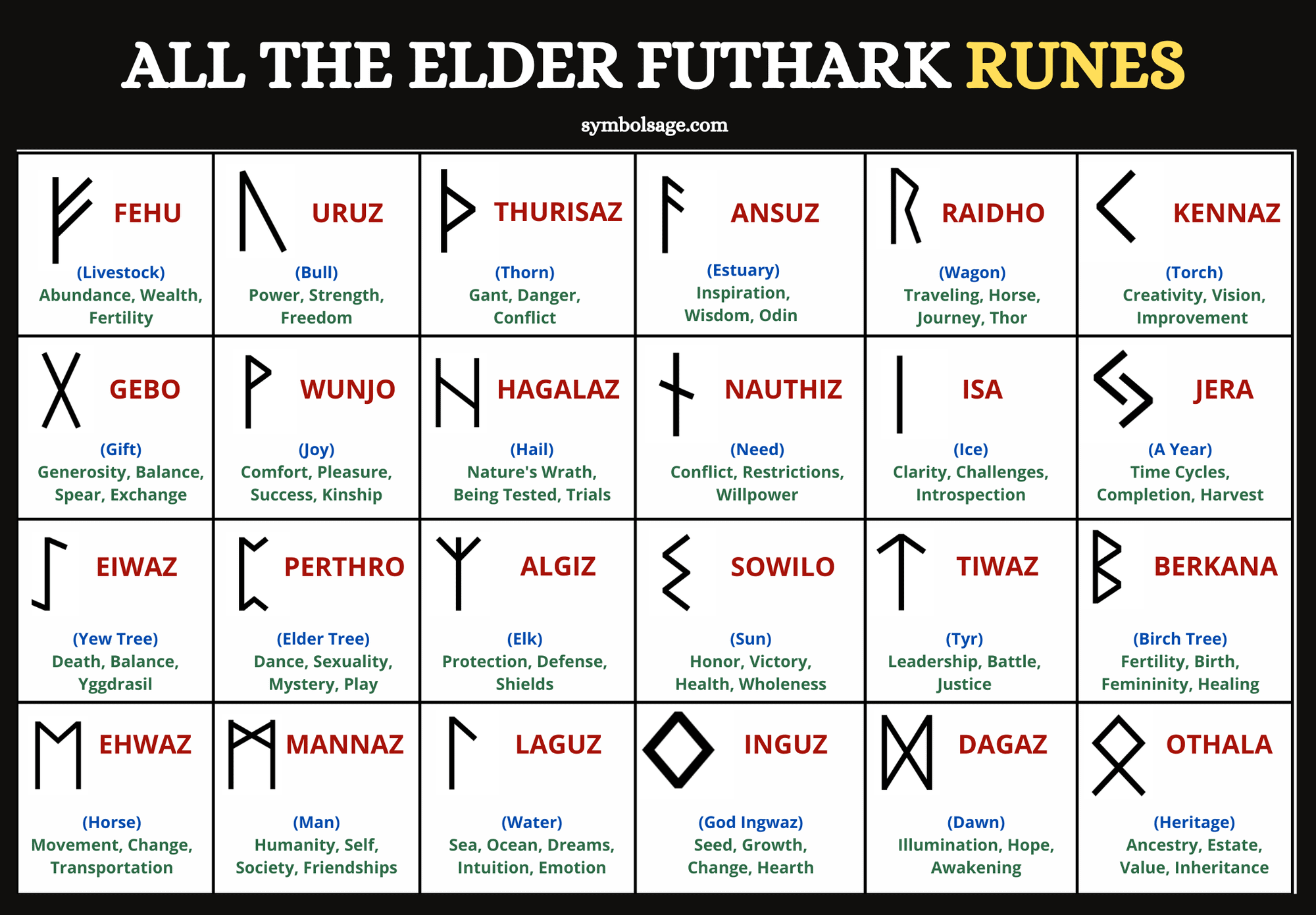
The Elder Futhark is comprised of 24 runes. At least that’s how many archeologists and historians have managed to find. The oldest discovered evidence of the Elder Futhark is dated to the early Migration Era of European history, between the 4th and 5th centuries AD. It was found in Sweden, on the Kylver Stone from Gotland.
Very little is known about these runes that historians and scholars don’t even agree on the exact meaning and interpretation of many of them. These 24 runes comprise the Elder Futhark, at least as we know it today. Used between the 2nd and 8th century AD, as far as we can tell, the Elder Futhark was eventually replaced by the Younger Futhark. According to the runestones, the 24 runes of the Elder Futhark are as follows:
- Fehu or Feoh – Livestock. Abundance, wealth, fertility, and success.
- Uruz or Ūr – Bull. Untamed, wild power, strength, and freedom.
- Thurisaz, þurs, or þorn – Thorn. Giant, danger, conflict, catharsis.
- Ansuz or Ōs – Estuary. Inspiration, wisdom, understanding, and Odin himself.
- Raidho or Ræið – Wagon. Traveling, horse, journey, spontaneity, and god Thor.
- Kennaz or Kaunan – Torch. Creativity, inspiration, vision, and improvement.
- Gebo or Gar – Gift. Generosity, balance, partnerships, spear, and exchange.
- Wunjo or Wynn – Joy. Comfort, pleaure, success, kinship, and harmony.
- Hagalaz – Hail. Nature’s wrath, the overcoming of obstacles, being tested.
- Nauthiz or Nauðr – Need. Conflict, restrictions, self-reliance, willpower, and personal strength.
- Isa or Is – Ice. Challenges, introspection, and clarity.
- Jera or Jeraz – A year. Time cycles, completion, harvest, reaping rewards.
- Eiwaz or Yew – Yew tree. The World Tree Yggdrasil, enlightenment, balance, and death.
- Perthro or Peord – Elder tree. Feminine energy, dance, sexuality, mystery, or play and laughter.
- Algiz or Eolh – Elk. Protection, defense, and shields.
- Sowilo or Sol – Sun. Honor, victory, wholeness, health, and thunderbolts.
- Tiwaz or Teiwaz – Tyr, one-handed lawgiver god. Leadership, justice, battle, and masculinity.
- Berkana or Bjarkan – Birch tree. Fertility, femininity, birth, and healing.
- Ehwaz or Eoh – Horse. Transportation, movement, and change.
- Mannaz or Mann – Man. Humanity, the self, individuality, human friendships, society, and cooperation.
- Laguz or Lögr – Water. Sea, ocean, people’s intuition, dreams, and emotions.
- Inguz or Ingwaz – God Ingwaz. Seed, masculine energy, growth, change, and a home’s hearth.
- Othala or Odal – Heritage. Ancestry, inheritance, estate, experience, personal possessions, and value.
- Dagaz or Dæg – Dawn. The day, illumination, hope, and awakening.
What is the Younger Futhark?
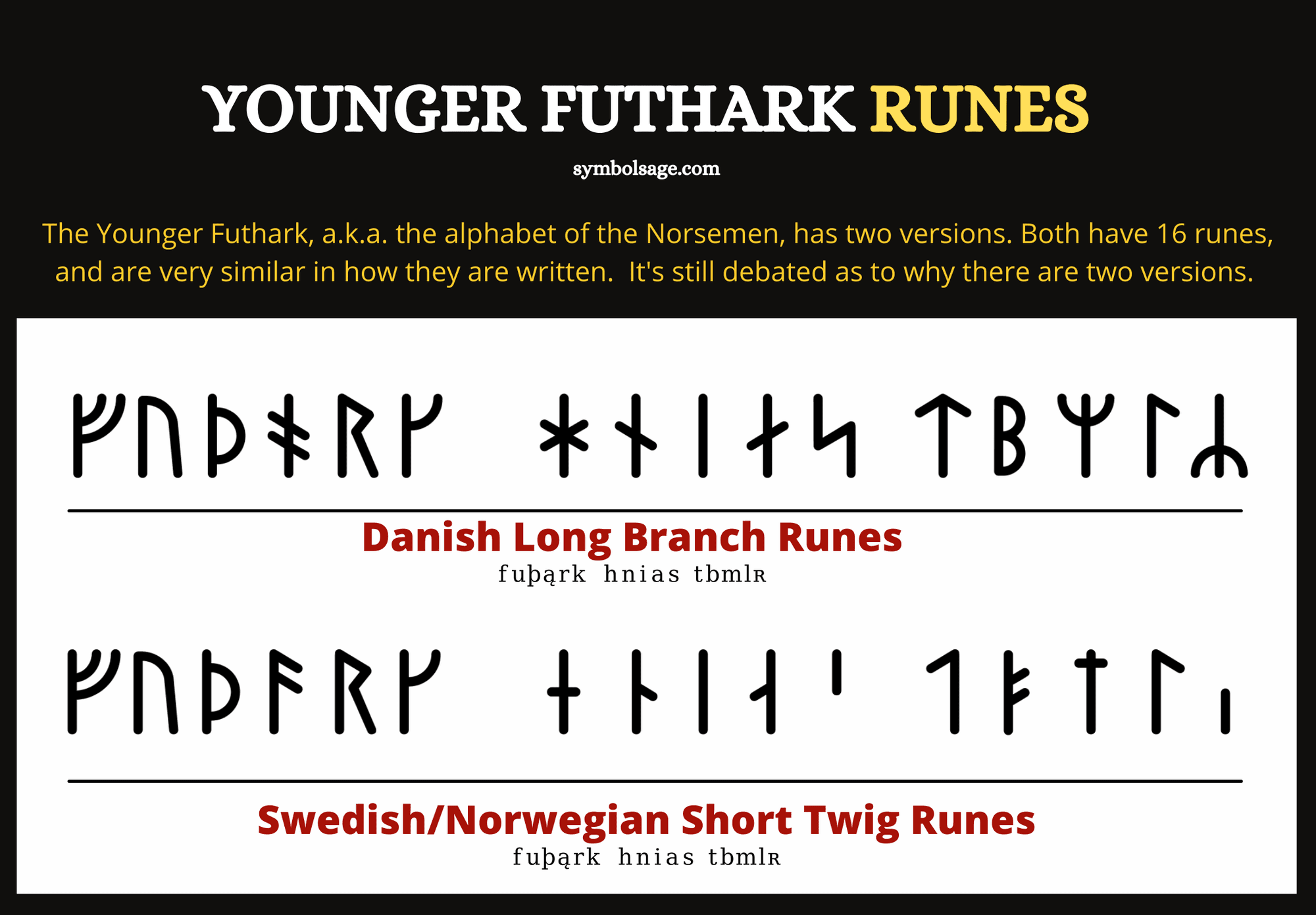
This new iteration of the Norse alphabet included only 16 runes but used them in a more complex manner. They also found more practical applications as they had to serve the Nordic people during the height of the Viking Age between the 8th and 12th centuries AD.
There are two versions of the Younger Futhark – the Danish long-branch runes and the Swedish/Norwegian short-twig runes. While we don’t really know why there were two versions, scholars speculate that perhaps the long-branch runes were used in documentation on stone, whereas the short-twig runes were used in daily life. Here’s what these 16 runes looked like and what they meant:
- Feoh or Frey – Wealth. Abundance, success, discord.
- Ūr or Ur – Shower. Snow, rain, and dross.
- Thurs or þurs – Giants. Danger, anguish, and torture.
- Oss or Æsc – Haven. Estuary and Odin himself.
- Reid or Rad – Horses. Riding, journeys, and moving at high speed.
- Kaun or Cen – Ulcer. Disease, death, and malady.
- Haegl or Hagall – Hail. Cold, deep freeze, cold grain.
- Naudr or Nyd – Need. Constraints, grief, state of oppression.
- Isa or Is – Ice. The bark of rivers, challenges, destruction.
- Ar or Ior – Plenty. Bountifulness and good harvest.
- Sol or Sigel – Sun. Shining ray, destroyer of ice.
- Tyr or Tir – The one-handed lawgiver god Tyr. Law, justice, and wolves.
- Bjarkan or Beork – Birch tree. Spring, new life, fertility, and femininity.
- Maðr or Mann – Man. Mankind, mortality, the delight of man.
- Lögr or Logr – Water. Rivers, geysers, and waterfalls.
- Yr or Eolh – Yew tree. The World Tree Yggdrasil, endurance, bent bow.
Are the Runes Magical?
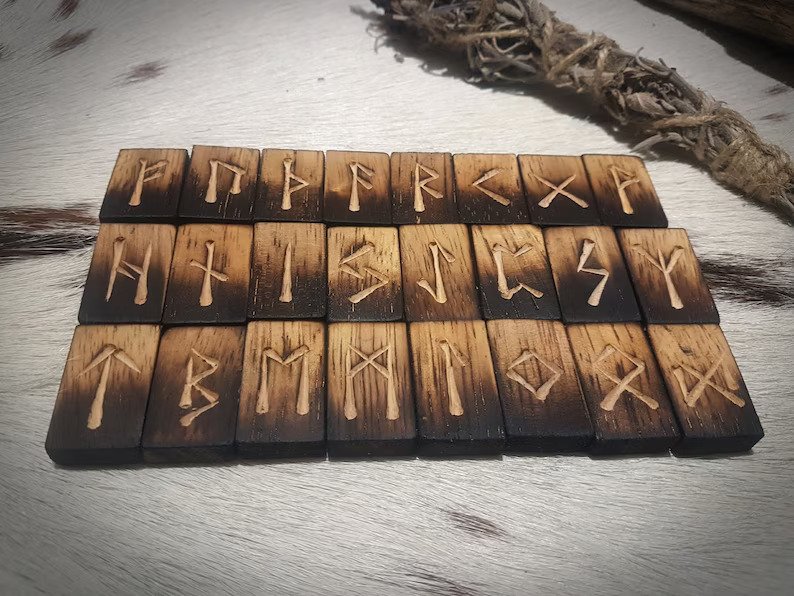
Beyond their practical use as a writing system, runes held deep symbolic significance and were believed to have magical properties. This is evident in sagas and folklore where runes could be used for divination, protection, invoking harm, or other magical purposes.
This is reflected in the myths and sagas, such as that of Odin hanging himself on Yggdrasil in order to gain wisdom. As the myth goes, after the ordeal, he was able to understand the magical wisdom of runes. This suggests that runes were believed to be more than just a writing system.
In modern times, especially within certain neo-pagan, occult, and esoteric circles, runes are used for divination and magical rituals. Each rune is believed to embody certain energies or concepts, and using them in specific ways can help manifest those energies or truths.
Wrapping Up
As you can see, the meanings of many Norse runes, old and new, are quite symbolic and abstract. These interpretations were taken from texts, songs, poems, and even single sentences and phrases carved into runestones. This has led to mixed and even contradictory beliefs about some runes and there is little consensus on what they mean. One thing is certain – Norse runes are mysterious and rich in meaning, as they are unique and beautiful.





